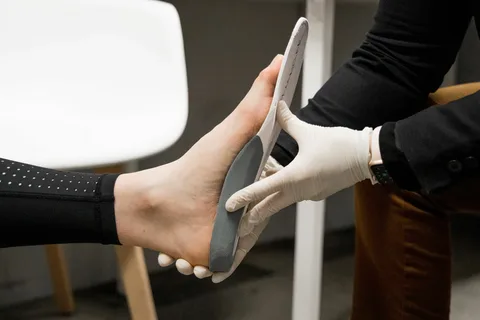Standing, walking, and moving comfortably depend on the precise alignment of the feet—yet small imbalances often go unnoticed until they cause pain. Custom orthotics designed by a plantar fasciitis doctor do more than ease heel discomfort; they help restore natural posture and balance throughout the body. By improving how each foot supports weight, these tailored inserts reduce fatigue and prevent long-term joint strain.
Correct Foot Alignment Balances Overall Body Posture
A misaligned foot changes how the entire body stands and moves. Even a minor shift in arch height or heel angle can alter spinal alignment and hip positioning. Customized orthotics correct these imbalances by guiding the feet into their natural orientation, allowing the knees, hips, and back to follow proper alignment.
This balanced posture reduces uneven stress on muscles and ligaments. A plantar fasciitis specialist evaluates the unique structure of each foot and designs orthotics that fit precisely, ensuring each step supports rather than strains the skeletal system. Over time, improved alignment enhances body symmetry and restores comfortable movement.
Custom Support Reduces Tension Through the Lower Limbs
The lower limbs absorb constant pressure throughout the day. When arches collapse or heels roll inward, the calf and thigh muscles work harder to stabilize movement. Custom orthotics relieve this burden by supporting the foot where it naturally needs it most, allowing the muscles to relax and function efficiently.
A plantar fasciitis doctor often identifies specific points of tension during gait analysis. With personalized orthotic support, the leg muscles engage more evenly, reducing fatigue and minimizing the micro-strains that contribute to chronic pain over time.
Even Weight Distribution Eases Pressure on Arches
Uneven weight distribution is a common source of arch pain. Customized orthotics spread body weight across the entire surface of the foot instead of concentrating pressure on one area. This reduces strain on the plantar fascia—the thick band of tissue running from heel to toes that often becomes inflamed in plantar fasciitis.
By stabilizing the arches, orthotics also help maintain proper blood flow and tissue health. Patients who use correctly fitted supports report less morning stiffness and faster recovery after standing for long hours. The result is better balance, stronger footing, and reduced stress on every step.
Stabilized Heel Placement Improves Walking Mechanics
Heel movement influences the chain of motion through the ankles, knees, and hips. Customized orthotics stabilize the heel by preventing it from rolling inward or outward during each stride. This correction helps distribute impact more evenly and reduces joint wear caused by repetitive missteps.
A plantar fasciitis specialist tailors heel cups and contours to absorb shock effectively. The design keeps the heel aligned through all phases of gait, making walking smoother and more controlled. This mechanical balance prevents compensatory habits that often lead to discomfort higher up in the legs and spine.
Tailored Cushioning Absorbs Impact from Daily Movement
Daily walking, running, and standing expose the feet to thousands of impacts. Generic insoles offer only surface padding, while customized orthotics use multi-layered materials that compress strategically to protect high-pressure zones. This advanced cushioning technology disperses energy from heel strikes, reducing fatigue and preventing microtrauma in soft tissues.
A plantar fasciitis doctor measures foot pressure points with digital mapping tools to determine where the cushioning should be most responsive. The result is a tailored insert that supports motion naturally and reduces the sharp jolt often felt in the heel or ball of the foot.
Proper Foot Positioning Relieves Strain on Knee Joints
Foot alignment and knee health are closely connected. If the feet roll inward or outward excessively, the knees are forced into unnatural positions with every step. Customized orthotics maintain correct foot positioning, helping the knees track properly over the toes.
This alignment minimizes stress on ligaments and cartilage around the joint. Many patients find that orthotics prescribed by a plantar fasciitis specialist relieve knee tension more effectively than braces or wraps because they correct the problem at its source—the feet. Over time, the improvement extends upward, easing strain on the thighs and lower back as well.
Controlled Motion Prevents Recurring Plantar Irritation
Recurrent plantar fasciitis often stems from repetitive stress caused by poor foot mechanics. Customized orthotics limit excessive movement in the arch and heel, reducing strain on the inflamed fascia. By guiding motion within a healthy range, they allow the tissue to heal while preventing future flare-ups.
A plantar fasciitis doctor evaluates walking and standing patterns to identify where control is needed most. Orthotics with structured arch support and deep heel cups stabilize motion during both standing and activity, creating an environment where the fascia can recover without continuous irritation.
Improved Gait Efficiency Reduces Back and Hip Discomfort
An efficient gait starts from the ground up. Misalignment in the feet can cause the pelvis to tilt or the lower back to overcompensate, leading to stiffness and soreness. Customized orthotics correct gait mechanics by supporting each foot’s natural roll from heel to toe, promoting balanced momentum.
Through careful design, a plantar fasciitis specialist ensures that orthotics reduce unnecessary rotation and sway during walking. Over time, this efficient movement pattern lessens tension in the lower back and hips, restoring comfort and stability with every stride. The benefits extend beyond pain relief—patients often notice increased endurance and smoother mobility throughout daily life.



